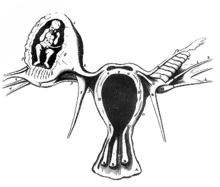Regnier de Graaf
Regnier de Graaf | |
|---|---|
 Portrait photo | |
| Born | 30 July 1641 Schoonhoven, Dutch Republic |
| Died | 17 August 1673 (aged 32) Delft, Netherlands |
| Nationality | Dutch |
| Known for | reproductive biology syringe ovarian follicle |
| Scientific career | |
| Fields | anatomist |
Regnier de Graaf (English spelling), original Dutch spelling Reinier de Graaf, or Latinized Reijnerus de Graeff (30 July 1641 – 17 August 1673), was a Dutch
Biography


De Graaf was born in
In May 1672 he married Maria van Dijk. As a correspondent of the
It has been speculated that he may have committed suicide, but it is more likely it was malaria, typhoid fever or dysentery as in other Dutch cities;[8][5] the disease persisted throughout the year, peaking in July and August.
Legacy


De Graaf's position in the history of reproduction is unique, summarising the work of anatomists before his time, but unable to benefit from the advances about to be made by microscopy, although he reported its use by Antonie van Leeuwenhoek in 1673. His personal contributions include the description of testicular tubules, the
Graafian follicles
His
Female ejaculation
De Graaf described
Weaknesses
Despite his contributions, De Graaf made a number of errors in addition to believing that the ovum was the follicle. He never actually consulted the ancient texts but merely repeated the accounts of others compounding their inaccuracies. Because he observed rabbits rather than humans, he assumed fertilization took place in the ovary. He believed that the
Publications
- De Graaf, R (1664) De succi pancreatici natura et usu exercitatio anatomico-medica
- De Graaf, R (1668) De Virorum Organis Generationi Inservientibus, de Clysteribus et de Usu Siphonis in Anatomia
- De Graaf, R (1672) De mulierum organis generationi inservientibus tractatus novus : demonstrans tam homines & animalia caetera omnia, quae vivipara dicuntur, haud minus quàm ovipara ab ovo originem ducere
- De Graaf, R (1686) Alle de Wercken. Leyden, Netherlands.
References
- ^ REINIER DE GRAAF EN ZIJN PLAATS IN HET FYSIOLOGISCH ONDERZOEK VAN DE ZEVENTIENDE EEUW by M.J. van Lieburg
- ^ "Reinier de Graaf | Lens on Leeuwenhoek".
- ^ "Van der Aa".
- ^ a b https://www.ntvg.nl/system/files/publications/1974107890001a.pdf [bare URL PDF]
- ^ a b Lindenboom G.A. (1974), p. 794
- ^ Burial record, p. 81
- ^ "Regnier de Graaf (1641-1673) | the Embryo Project Encyclopedia".
- ^ Levenstekens: Gekaapte brieven uit het Rampjaar 1672 by Judith Brouwer, p. 279
- PMID 9080233.
- ^ PMID 4567037.
- PMID 10923067.
- ^
Jon E. Roeckelein (2006). Elsevier's Dictionary of Psychological Theories. ISBN 978-0-444-51750-0. Retrieved October 8, 2012.
- .
Other sources
- Houtzager HL. Reinier de Graaf 1641–1673 (ISBN 90-5235-021-3.
- Houtzager HL (2000). "Reinier De Graaf and his contribution to reproductive biology". European Journal of Obstetrics, Gynecology, and Reproductive Biology. 90 (2): 125–7. PMID 10825629.
- Modlin IM; Director Gastric Pathobiology Group (2000). "Regnier de Graaf: Paris, purging, and the pancreas". Journal of Clinical Gastroenterology. 30 (2): 109–13. PMID 10730914.
- Longo LD; Degraaf, R (1996). "De mulierum organis generationi inservientibus tractatus novus". American Journal of Obstetrics and Gynecology. 174 (2): 794–5. PMID 8623824.
- Wiesemann C (1991). "Regnier de Graaf (1641–1673)" [Regnier de Graaf (1641–1673)]. Der Pathologe (in German). 12 (6): 352–3. PMID 1792221.
- Houtzager HL (1981). "Reinier de Graaf". European Journal of Obstetrics, Gynecology, and Reproductive Biology. 12 (6): 385–7. PMID 7037492.
- Gysel C (1978). "Reinier de Graaf (1641–1673) and the syringe" [Reinier de Graaf (1641–1673) and the syringe]. Nederlands Tijdschrift voor Tandheelkunde (in Dutch). 85 (5): 216–8. PMID 379667.
- Mann RJ (1976). "Regnier de Graaf, 1641–1673, investigator". Fertility and Sterility. 27 (4): 466–8. PMID 773713.
- Lindenboom GA (May 1974). "Reinier de Graaf (1641–1673)" [Reinier de Graaf (1641–1673)]. Nederlands Tijdschrift voor Geneeskunde (in Dutch). 118 (21): 789–95. PMID 4597505.
- "Reinier de Graaf and the Royal Society of London" [Reinier de Graaf and the Royal Society of London]. Nederlands Tijdschrift voor Geneeskunde (in Dutch). 117 (28): 1049–55. 1973. PMID 4595333.
- Lindberg J (1963). "Regnier de GRAAF" [Regnier de GRAAF]. Nordisk Medicin (in Swedish). 69: 108–12. PMID 13930746.
- Ruler Han van (2003). 'Graaf, Reinier de (1641-73)' The Dictionary of 17th and 18th-Century Dutch Philosophers. Bristol: Thoemmes, 2003, vol. 1, 348–9. ISBN 1-85506-966-0.
- Ruler Han van (2007). 'Graaf, Reinier de' Dictionary of Medical Biography. Westport, Conn.: Greenwood, 2007, vol. 2, 570.
- Speert H (1956). "Obstetric-gynecologic eponyms; Reinier de Graaf and the graafian follicles". Obstetrics and Gynecology. 7 (5): 582–8. PMID 13309944.
